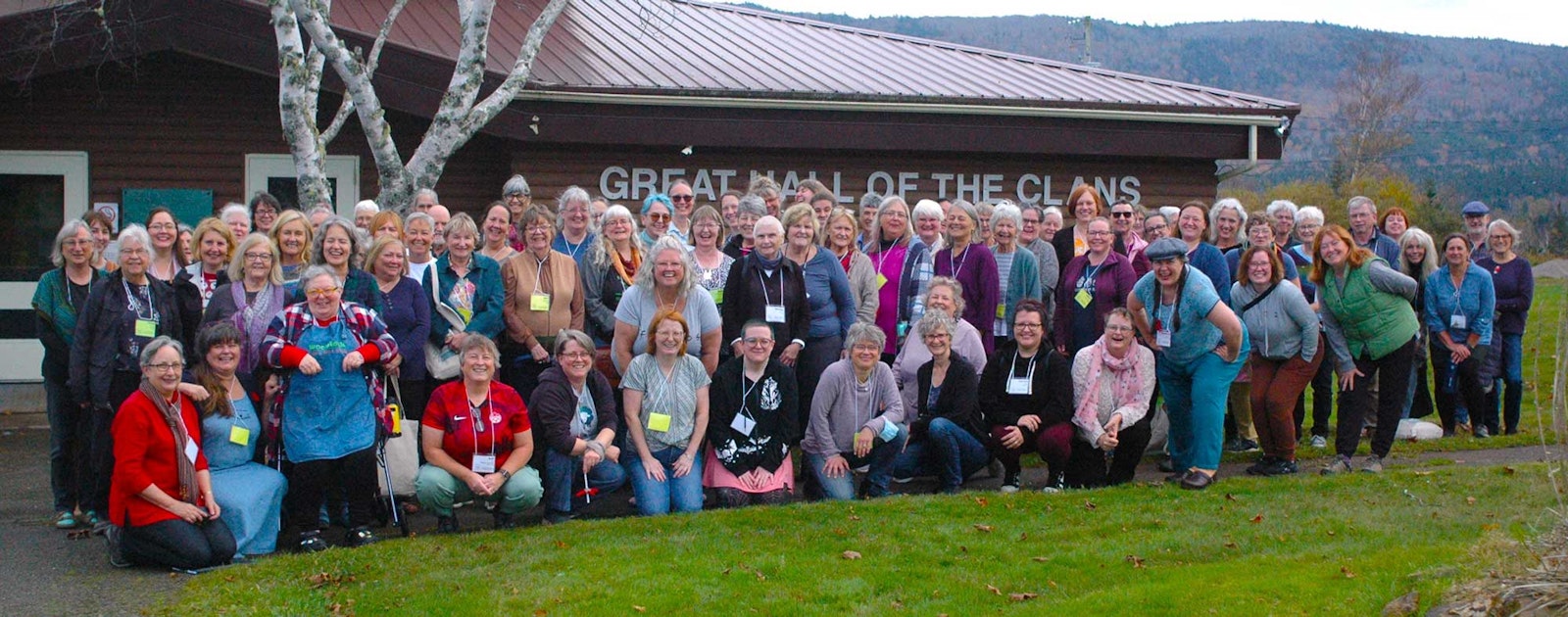Spinners often seek each other’s company while enjoying our craft. In groups, we share equipment and techniques, mentor new spinners and acquire new fiber to spin. It is often a getaway—a retreat to relax and reinvigorate our spirits.
In many communities in Cape Breton and elsewhere, spinners’ gatherings used to have a different purpose. When spinning was an important part of daily work, it was often done communally, as were many other tasks such as quilting, fulling woven wool cloth (milling), and barn raising. Unlike modern spinning retreats, spinning frolics were for serious work and attendance was by invitation only. Spinning frolics included all ages and the craft was taught and learned ‘on the job,’ often using legends and anecdotes. All aspects of the production of wool cloth including shearing of the sheep, picking, washing and carding of the fleece, and then spinning of the yarn provided opportunities to organize frolics.
Weaving, on the other hand, was a solitary pursuit. Waulking (fulling) the woven cloth warranted a milling frolic where the wet cloth was run over a corrugated board or old door by many hands moving to the rhythm of milling songs. In Cape Breton, the spun, woven, and fulled woolen cloth was often used to make heavy, almost waterproof clò mòr (big cloth) for men’s and boy’s clothing.1
 Photo from Wool to Waulking video with Norman Kennedy; Long Thread Media
Photo from Wool to Waulking video with Norman Kennedy; Long Thread Media
A Community Gathering
Fiber frolics involved the women of the community. The men took advantage of these gatherings and co-operatively accomplished heavier tasks such as cutting wood, planting, harvesting, and building. When the end of the working day came, fine meals were shared. The host prepared the meal from assorted foods contributed by the workers and there was often quite a competition among neighbors to produce the best spread at their frolic. After the meal, the party began. Singing, playing the fiddle, and dancing were the main activities, perhaps fueled by snuff and a wee dram or two of scotch.2
Some well-intentioned frolics were a bit rowdy, leading some clergy to prohibit the scotch. Nevertheless, the music and dance at the frolics evolved into a special Cape Breton style, still celebrated on the island.3
A common belief is that the best time for spinning is when the sheep are asleep. Perhaps this originated because curious children, along with the sheep, were then tucked safely into their beds away from the industrious party-goers. The festivities often went into the wee hours of the night.
 Image courtesy of Baile Nan Gàidheal | Highland Village Museum. Image is a spinning frolic in MacKinnon's Harbour between 1931 and 1946.
Image courtesy of Baile Nan Gàidheal | Highland Village Museum. Image is a spinning frolic in MacKinnon's Harbour between 1931 and 1946.
Although I have enjoyed many retreats with other spinners, I have only attended a few frolics. It may be time to bring back the communal work of a frolic to the camaraderie of the retreat. Spinners could unite to make yarn for a common purpose such as a woven blanket for a new community member or hats and mittens to warm the less fortunate. I have heard it said that many hands make light work and the frolic embodies that philosophy. When the work is done, the party can start. Now, that is truly social spinning with intent!
Notes
- MacLeod, E. & MacInnes, D., Celtic Threads A Journey in Cape Breton Crafts. Sydney, Nova Scotia: Cape Breton University Press, 2014.
- Watson, J. & Robertson, E. Sealladh Gu Taobh Oral Tradition and Reminiscence by Cape Breton Gaels. Sydney, Nova Scotia: Art Gallery, University College of Cape Breton, 1987.
- MacLeod & MacInnes, Celtic Threads.
Resources
- Annamarie Hatcher, “Scottish Spinning Traditions in Cape Breton,” Spin Off, Winter 2018, 24–26.
- W.J. Davey and R.P. MacKinnon. Dictionary of Cape Breton English. Toronto: Univ. of Toronto Press, 2016.
- T. MacIsaac. A Better Life: A Portrait of Highland Women in Nova Scotia. Sydney, Nova Scotia: Cape Breton University Press, 2006.
- Watch waulking in action in the video From Wool to Waulking: Spinning Wool and Creating Cloth with Norman Kennedy.
- Start a spinning frolic with your friends and guild members, or find one near you, like the one happening at The Newbury School of Weaving from June 28–29, 2025.
Annamarie Hatcher is a freelance writer who enthusiastically blends handspinning and science. She is a retired research scientist with a PhD in zoology from the University of Western Australia and has been spinning for well over 45 years in her “free” time. She lives in Cape Breton surrounded by fiber folk.

